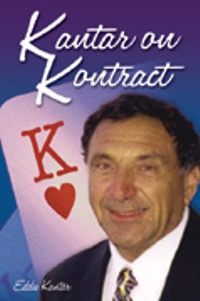During each day of the NABC (National American) Eddie Kantar, one of the best American bridge writers, analyzes one bridge hand, for players who want to improve their bridge. This is the 4th day’s hand of the San Francisco NABC 2012:
|
| Oeste | Norte | Este | Sur |
| 1 |
Pass | 1 |
|
| Pass | 2 |
Pass | 4 |
| The End |
Lead: ![]() A
A
Bidding commentary: If the bidding didn’t go this way, don’t mention it in public.
Lead commentary: As West, the best time to lead from shortness is when holding trump control – e.g., A-x, A-x-x, K-x-x. In this case, you can visualize defeating the contract if partner has the ![]() K (immediate ruff) or a minor-suit ace, in which case you will put partner in after winning the
K (immediate ruff) or a minor-suit ace, in which case you will put partner in after winning the ![]() A and get a ruff.
A and get a ruff.
Play commentary: As South win the ![]() K at trick two (higher equal for deceptive purposes) and lead a spade.
K at trick two (higher equal for deceptive purposes) and lead a spade.
Defensive commentary: As West, if South leads a spade at trick three, no point in rushing up with the ace. You would do that if you had a doubleton ace, but in this case partner might have a singleton king! If you did start with the doubleton ![]() A, you would have to win and guess which ace partner has. On the actual layout, if partner has a singleton spade, his discard on the second spade will tell you what you need to know.
A, you would have to win and guess which ace partner has. On the actual layout, if partner has a singleton spade, his discard on the second spade will tell you what you need to know.
Defensive commentary# 2: As East, discard the ♦2 on the second spade, discouraging. You have been cursed with such terrible club spots that partner might not read the ![]() 3 as encouraging! If, for one of many reasons, you cannot signal encouragement in one suit, signal discouragement in the other. It’s six of one, a half dozen of the other. Assuming partner is breathing and shifts to a club upon winning the second spade, you win and give partner a heart ruff. Note: Some play “upsidedown” attitude signals. Using this method, a low card is an encouraging signal and a high card is
3 as encouraging! If, for one of many reasons, you cannot signal encouragement in one suit, signal discouragement in the other. It’s six of one, a half dozen of the other. Assuming partner is breathing and shifts to a club upon winning the second spade, you win and give partner a heart ruff. Note: Some play “upsidedown” attitude signals. Using this method, a low card is an encouraging signal and a high card is
discouraging. Be familiar with your opponents’ signaling methods.
